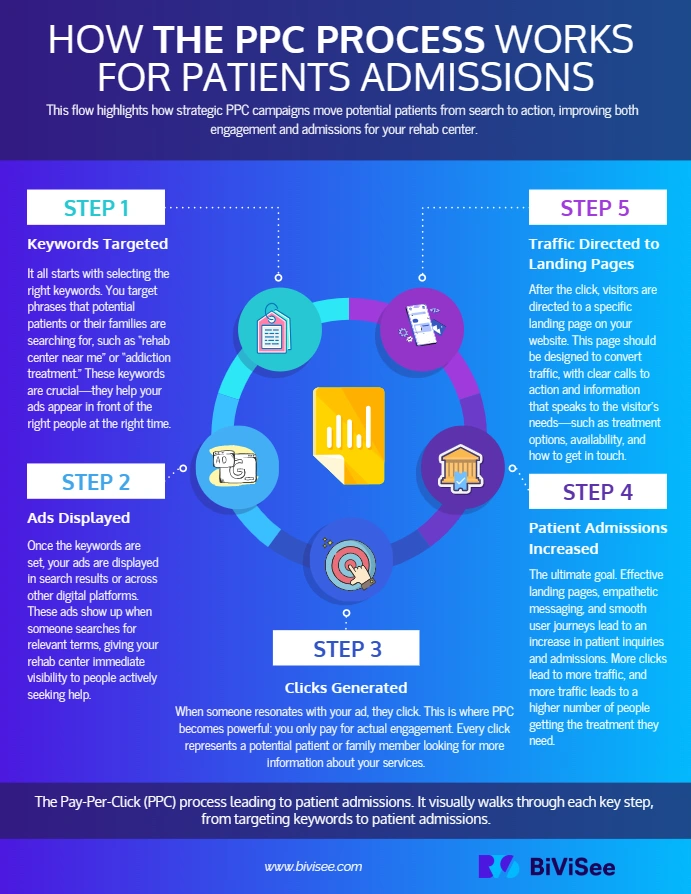Table of Contents
best PPC strategies for drug rehab centers
Enhance Your PPC Strategy with Our Exclusive Checklist!
Introduction: Mastering Budgeting in Drug Rehab PPC Advertising
Budgeting in drug rehab online advertising goes beyond crunching numbers—it’s the key to achieving strategic growth in a highly regulated and competitive field. How you allocate every dollar can make a significant impact, not just for your center but for the lives of those seeking rehabilitation. Let’s explore why budget management matters and how it can elevate your PPC campaigns.
Why Budgeting Matters in Rehab PPC Campaigns
Effective budget management is the backbone of successful PPC campaigns in drug rehab marketing. It’s about more than spending—it’s about saving lives by maximizing outreach. Every dollar spent wisely enhances the visibility of your center, allowing you to connect with individuals in need at the most crucial moments.
The Impact: Did you know that a well-managed budget can increase profitability by up to 20% in the healthcare sector (Source: Forbes Business Council, 2022)? This shows just how critical resource allocation is in shaping your campaign’s success.
The Landscape: Challenges in Drug Rehab Online Advertising
Drug rehab marketing is a tricky space to navigate. Stringent regulations and fierce competition demand careful, calculated steps. It’s not enough to simply run ads; you need to know how to deploy them effectively while staying within industry regulations.
- Compliance: Drug rehab centers must adhere to strict advertising guidelines, and any misstep can lead to fines or even suspension of ad accounts.
- Competition: The online advertising space for rehab centers is highly saturated, meaning only the most strategic campaigns break through.
Does your current strategy take into account both the regulatory landscape and the need to outsmart competitors?
The Benefits of Budget Management
Cost management doesn’t just help you stay within budget—it directly influences your center’s ability to attract patients. A well-allocated budget can enhance your marketing efforts without wasting precious resources. Here’s why it matters:
- Improved Visibility: A targeted budget ensures your ads are seen by the right people at the right time, boosting patient inquiries.
- Optimized Resource Allocation: When funds are strategically allocated, they translate into higher efficiency and a better return on investment (ROI).
Consider how an optimized budget can fuel your PPC campaigns, reducing wasted spend and enhancing outreach efforts. Isn’t it time to fine-tune your budget for maximum efficiency?
Advertising Precision: The Secret Weapon of PPC Specialists
For advertising professionals, granular cost precision is where the real magic happens. It’s not enough to simply create ads—you need to understand the exact cost of every keyword, every bid, and how each translates into conversions.
- Precision in Costs: Effective cost control ensures your ads remain competitive without overspending.
- Conversion Focus: Ultimately, the goal is to turn clicks into patients. A well-optimized PPC campaign not only draws traffic but also converts that traffic into tangible leads.
The Technical Angle: Specialists understand that without precise bidding strategies and careful keyword management, a campaign can quickly spiral out of control. It’s not about getting the most clicks—it’s about getting the right clicks.
Strategic Budget Benefits: Efficiency, Allocation, and ROI
Let’s break down the strategic benefits of careful budget management in PPC advertising for drug rehab centers:
- Improved Efficiency: When you know where your dollars are going, you can sharpen your focus and make every cent count.
- Enhanced Resource Allocation: Direct funds towards high-performing keywords, audiences, and strategies that yield the best results.
- Boosted ROI: A well-managed budget ensures your advertising dollars are spent where they’ll have the greatest impact, driving higher returns.
This approach transforms your budget from a simple financial plan into a powerful tool for growth and outreach. Imagine improving your center’s patient intake by fine-tuning your ad spend. How would that change your overall impact?
Balancing High Costs and Effective Outreach
As a marketing manager or advertising specialist, you face the dual challenge of managing high costs and ensuring effective outreach. The key to success lies in strategic budget management. Every dollar saved through optimization can be redirected towards furthering your center’s mission—connecting with individuals seeking a path to recovery.
Cost management isn’t just a business necessity—it’s the foundation of impactful advertising. By controlling costs, you can increase the reach and effectiveness of your PPC campaigns, delivering more value and generating better results.
Start today by refining your budget strategy.
Let’s make a difference!Understanding Online Advertising for Drug Rehab Centers
Online advertising is an essential tool for drug rehab centers, transforming how they connect with individuals seeking recovery. But what role does PPC (Pay-Per-Click) advertising play, and how does it drive results? Let’s dive into why PPC is so effective in this industry and how it can directly influence patient admissions and boost ROI.
The Role of PPC in Drug Rehab Marketing
Imagine PPC advertising as a lifeline for your rehab center’s marketing efforts. Why? Because it offers immediate visibility at the exact moment potential clients are actively searching for treatment. By bidding on relevant keywords, your rehab center shows up in search results when someone is seeking help. This isn’t just a chance encounter—it’s a strategic positioning that cuts through the noise and addresses those in urgent need.
For a layperson, think of PPC like buying prime real estate at a busy intersection. You only pay when someone enters your “store” by clicking on your ad. And each click represents more than just traffic—it’s a potential step toward someone’s recovery.
From a technical perspective, PPC works through algorithms that match your chosen keywords with search queries. These algorithms determine if and when your ad appears, ensuring you connect with the right people at the right time. Unlike organic methods, PPC guarantees immediate visibility and measurable results.
But how does this actually work?

This simple chain illustrates how PPC moves potential patients from searching to considering, and ultimately, contacting your center for help.
Benefits of Online Advertising for Drug Rehab Centers
Have you considered the strategic advantages of online advertising for drug rehab centers? Let’s break down why it’s a game-changer. The true power of online ads lies in their ability to reach far beyond traditional methods, connecting you with people who are actively searching for help. You’re not just reaching a larger audience—you’re reaching the right audience at the exact moment they need you most.
Targeting precision is the secret weapon here. While traditional advertising methods are like casting a wide net, hoping to catch something, digital advertising is more like a spear—it hits the target with pinpoint accuracy. Algorithms allow you to focus your ads on those who are searching for specific rehab services, ensuring that your message reaches people who are ready to take action.
Consider a comparison between traditional and digital marketing strategies. Traditional advertising relies on broader outreach but often lacks measurable engagement. Digital marketing, on the other hand, offers higher reach and conversion rates due to its ability to target individuals with laser-like precision. Why settle for casting a wide net when you can target exactly who needs you?
For CMOs, this means shifting from a strategy of broad outreach to focused, data-driven engagements that yield tangible results. For digital marketers, it’s about delving into the algorithms that decide which ads get shown to which people—and why.
The Strategic Advantage: Reach, Engage, Convert
The benefits of online advertising for drug rehab centers are clear: greater reach, higher engagement, and better conversion rates. When you advertise online, you’re not just increasing visibility—you’re increasing targeted visibility. Your ads are seen by those who are already searching for solutions, making the connection between their need and your service seamless.
- Enhanced Reach: Reach beyond local areas to target people actively seeking rehab services nationwide or globally.
- Increased Engagement: Digital ads allow for real-time interaction, making it easier to connect with potential patients as soon as they’re ready to take the next step.
- Improved Conversions: With more accurate targeting, you’ll convert more clicks into inquiries and admissions, ensuring your marketing dollars are well spent.
Consider Rehab Center A, which doubled its engagement by using personalized, data-driven ads that spoke directly to the needs of its target audience. Case studies like this illustrate the human side of digital marketing—showing how numbers turn into meaningful connections and statistical success transforms into lives saved.

Lead your team toward smarter advertising solutions that drive patient recovery and organizational growth.
Start today!Budget Management Strategies for PPC Campaigns
In the highly competitive field of drug rehab marketing, managing a PPC (Pay-Per-Click) campaign budget requires strategic planning, just like a captain steering through stormy seas. There’s no denying it: PPC can be a financial sinkhole if not monitored with hawk-eyed precision. So, how does one set a realistic budget without letting investment seep like water through fingers?
Setting a Realistic Budget for PPC Campaigns
Budget setting is much like plotting your campaign’s course; it’s essential to your voyage. Start by evaluating the competition. According to WordStream, the average Cost-Per-Click (CPC) for health and medical industries hovers around $3.27, but this can skyrocket based on keyword competition and location. The higher the stakes, the more you should prepare to spend. Incorporate these costs into your strategy as fuel is to a ship’s journey.
In creating your budget, consider your business objectives. Are you after leads, or conversions? Each goal dictates your spending and the breadth of your PPC sails. The trick is to prioritize; put your resources where they will catch the most wind, propelling business objectives forward.
How do experts navigate this labyrinth? Financial analysts take a magnifying glass to profitability and revenue goals. Their sharp eye sees potential and pitfalls, ensuring budgets align with expected returns. Small business owners tread a pragmatic path, keeping things practical, breaking numbers down to bite-sized pieces.
Cost-Effective PPC Strategies
Once your budget is on course, the next step is optimizing your campaign to trim the fat. CPC optimization is key here. Just like fine-tuning a musical instrument, tweaking elements of your PPC campaigns harmonizes cost and conversion. The golden question: How can you pay less for each click while reaching more potential patients?
Consider split testing ad copies and adjusting bid strategies. A data-driven approach can be your compass, guiding decisions on which strategies work. Scientific Advertising author Claude Hopkins once declared, “Test everything, assume nothing.” His advice rings true in today’s data-saturated world.
Incorporate comparison tables to weigh different PPC strategies. For instance, remarketing often shows promising returns by targeting previous visitors, a welcoming hand to those who tread close to conversion but turned away. Cost managers thrive in these statistics, finding delight in data-driven insights—metrics closely examined, showing a direct line to cost reduction.
Let’s bring it all together with narratives of real success, where drug rehab centers streamlined their budgets and witnessed an increase in patient admissions despite lowered ad spend. These stories light up possibilities, revealing that with insight and strategy, budget boundaries need not interfere with impact.

Consider how these insights can transform your approach to PPC management.
Let’s work together!Best PPC Strategies for Drug Rehab Centers
Keyword Research and Selection
Are you curious about the cornerstone of successful PPC campaigns? It all begins with keyword research and selection. Within the competitive arena of drug rehab marketing, choosing the right keywords can make or break your advertising efforts. Why does it matter so much? Simply put, targeted keywords directly influence your reach to potential clients.
Utilizing effective tools, like Google Keyword Planner, can unveil a reservoir of keyword opportunities. Such tools provide data on search volumes and trends that can help you decide which keywords are worth your investment. Google’s service isn’t the only gem out there. Consider SEMrush and Ahrefs, both offering a robust suite of features to dig deeper into keyword strategies.
Now, for SEO experts, trends in keyword evolution hold tremendous significance. They recognize patterns and adapt strategies accordingly, staying ahead of the competition. On the flip side, novices may dare to tread a more descriptive path, learning the fundamentals and gradually mastering the art of keyword selection.
Hypothetical examples bring the lesson home. Imagine a drug rehab center targeting “addiction treatment programs” and “alcohol rehab.” By refining these choices to “best outpatient addiction treatment” or “top-rated alcohol rehab near me,” one could significantly enhance visibility and draw in more qualified leads.
Creating Effective PPC Ads
Crafting effective PPC ads goes beyond simple text arrangements. How does one transform words into enticing lures that capture attention? The secret lies in harmonizing ad copy with compelling visuals and enticing call-to-actions (CTAs).
Ad copy should resonate like music to the ears of potential clients, drawing them in with empathy and understanding. Strategies diverge between creative specialists, who weave messages with artistic flair, and analytics experts, who rely on data-backed decisions to fine-tune their ads.
In terms of priority attributes, compelling headlines rank top, followed closely by a precise CTA and relevant, high-quality visuals. A pleasant surprise is how even minor tweaks in phrasing or image selection can lead to notable boosts in engagement rates.
To provide additional insights, interviews with successful advertisers underscore the guiding principles of compelling ads. These conversations highlight the art of balancing creativity with strategic considerations, ensuring that ads neither mislead nor fall flat on impact.
Optimizing Landing Pages
Imagine this: a visitor clicks on your PPC ad; what comes next? The landing page acts as a bridge, converting curiosity into commitment. The art of landing page optimization involves psychological acumen, design principles, and the rigorous practice of A/B testing.
From a design-focused viewpoint, UX considerations are paramount. These ensure that pages not only allure visually but also offer intuitive navigation. Marketing execs, meanwhile, concentrate on conversion outcomes, pushing for those minor design tweaks which can yield major results.
Pre-and post-optimization checklists compare various features such as loading speed, mobile responsiveness, and clear calls to action. Did you know even a reduction in page load time by one second can drastically increase conversion rates? These small but mighty changes illustrate the immense potential of landing page refinement.
Feedback from real users, who traverse the optimized pages, provides invaluable insight. Their experiences reveal practical ways of enhancing user engagement and satisfaction. By listening to this feedback, companies can iterate their designs effectively.

Take the lead and revitalize your online presence today.
Contact us today!Monitoring and Adjusting PPC Campaigns
Tracking and Analyzing Performance Metrics
Imagine you’re at the helm of a complex machine—one that’s all about precision. This is the essence of performance metrics in PPC campaigns. Understanding these metrics is like having a compass during a storm. Essential metrics include click-through rates (CTR), conversion rates, and return on investment (ROI). Each of these numbers tells a story of how effective your campaigns are, making them integral to any drug rehab center looking to maximize their online advertising effectiveness.
In the pursuit of effective tracking, tools like Google Analytics are as indispensable as a sailor’s sextant. Google Analytics not only provides granular data but also offers the context needed for informed decisions. With this toolkit, you gain insight into who is clicking your ads and whether these clicks translate into new patient admissions. For instance, a high CTR might seem encouraging, but if conversion rates falter, it’s like a promising lead that fizzles out.
A dual-perspective analysis is key here: While data analysts dive into the ocean of numbers and emerge with actionable insights, campaign managers require a strategic viewpoint. They need a bird’s eye view, assessing which numbers are most critical to achieving long-term business objectives. Campaign managers might find themselves asking: How do different message types impact CTR? What changes in bidding strategy have influenced ROI recently?
For data-driven individuals, a well-structured table highlighting these performance metrics alongside their definitions and importance might be similar to a treasure map. Such structured data not only clarifies complex dynamics but also directs attention to areas needing adjustment. A simple table can reveal where you’re winning and where more effort is needed.
Real-world stories of organizations effectively leveraging these insights can inspire you. One company might discover that altering their ad scheduling improves their conversion rates, setting their email alert system to flag any significant metric shifts quickly. With data in hand, decision-making becomes both a science and an art, blending quantitative evidence with strategic acumen.
Making Data-Driven Adjustments
Staring at a spreadsheet might not sound thrilling, yet it holds the power to transform campaigns through data-driven adjustments. Why guess when you can rely on hard numbers? Using performance data effectively involves reading these digital tea leaves to guide actionable improvements. This continuous fine-tuning epitomizes what it means to optimize.
One of the fundamental adjustments involves analyzing patterns over time. Just as no two storms are alike, every campaign brings its own challenges and opportunities. Observing when CTR peaks and troughs can determine if a tweak in keyword strategy is necessary. Google Ads provides insights into search terms and engagement levels, revealing adjustments that could boost ad relevance or timing (HubSpot, 2022).
The fusion of technical insights with strategic recommendations empowers teams to become nimble and proactive. It’s about making the right move at the right time, akin to a chess master anticipating their opponent’s next step. Imagine a strategist noticing a decline in conversions post-click; they might deduce that landing page improvements are necessary. Meanwhile, performance analysts could recommend a pivot in ad copy based on engagement metrics, allowing for an integrated approach that marries data with strategy.
Engagement doesn’t only come from factual promises but also from posing questions around real data cases. How would an increase in mobile traffic influence our bidding strategy? Which time of day are we seeing the highest conversion rates? Engaging with such questions not only sharpens focus but spurs creative problem-solving.
In the end, confidence breeds competence. By embracing data-driven adjustments, marketers feel prepared to adapt campaigns flexibly, ensuring no opportunity slips through their fingers. This isn’t just about tracking numbers; it’s a dance of analysis and response, a cycle of perpetual growth and improvement.

Harness the power of analytics for transformative growth.
Contact us today!Conversion Rate Optimization (CRO) for Rehab PPC Campaigns
Understanding Conversion Rate Optimization
Conversion Rate Optimization (CRO) is a critical element in PPC campaigns, especially in the highly sensitive and impactful world of drug rehab marketing. But what exactly is CRO? At its core, CRO is about improving the percentage of website visitors who take the desired action, such as calling a center or filling out an inquiry form. In the context of drug rehab services, each conversion could be life-changing, making optimization essential for helping more people.
Why does CRO matter so much?
In drug rehab marketing, every click represents a person potentially seeking help. Therefore, optimizing each step in the user’s journey can dramatically increase the number of people getting the support they need. CRO is essential for maximizing the impact of your marketing efforts—ensuring your campaigns lead to real results, not just traffic.
Studies have shown that CRO techniques can boost conversion rates compared to non-optimized campaigns. Without CRO, even a high volume of website traffic may translate into low engagement, causing missed opportunities to connect with people in need.
CRO allows both traditional marketers and data-driven analysts to fine-tune their approaches, leading to better outcomes in an industry where every connection counts.
Implementing CRO Strategies
How can drug rehab centers implement CRO successfully? The key lies in blending practical techniques with data-driven insights. Let’s explore effective strategies to increase conversions and make every PPC campaign more impactful.
Techniques for Success
- A/B Testing: One of the most powerful CRO tools, A/B testing involves comparing two versions of a webpage or ad to see which one performs better. For rehab centers, you might test different headlines, call-to-action (CTA) buttons, or images to see which resonates most with potential patients. For instance, testing “Get Help Today” versus “Start Your Recovery Now” can provide insights into what drives engagement.
- User Feedback: Direct feedback from your audience can be invaluable. Use surveys or feedback forms to gather insights about the user experience. Understanding how visitors interact with your website can help you refine your messaging and design to better meet their needs.
Practical Implementation
Align your CRO strategy with your mission. The website’s purpose should be clear, and its calls to action should be intuitive and direct. Ensure that the pathway from ad click to conversion is simple and that users don’t face unnecessary hurdles. For example, if a potential patient lands on your page but has to click through multiple screens, you may lose their attention. Streamline the process to make it as easy as possible for them to contact you.
Additionally, advanced tracking is essential. Use analytics tools to precisely track user behavior, identifying where visitors drop off and adjusting your strategy accordingly. Data from tools like Google Analytics or Hotjar can show you what’s working and what needs improvement.
To illustrate, a comparison table of conversion rates before and after implementing CRO strategies can provide a clear picture of success:
| Conversion Metric | Before CRO | After CRO |
|---|---|---|
| Website Conversion Rate | 3% | 5% |
| Lead Form Completion | 50 per month | 80 per month |
| Cost Per Acquisition (CPA) | $120 | $85 |
This kind of data visualization is crucial for making decisions and showcasing improvements to stakeholders.
Tips for Effective CRO
- Empathetic Messaging: The way you communicate with potential patients can make or break a conversion. Use empathetic language that addresses their fears and needs. For example, phrases like “You’re not alone” or “We’re here to help” can be more effective than generic slogans.
- Mobile Optimization: In today’s digital landscape, a seamless mobile experience is non-negotiable. Over 50% of users now access websites through their smartphones, so ensuring your site is responsive and easy to navigate on mobile devices is crucial for maximizing conversions.
- Personalized User Journeys: Not all visitors are the same. By segmenting your audience and offering personalized experiences, you can engage visitors more effectively. For instance, a visitor searching for alcohol rehab may benefit from a different landing page and messaging than someone searching for opioid treatment.
These CRO strategies, underpinned by data and user feedback, can significantly improve the impact of your PPC campaigns. By refining your messaging, simplifying user interactions, and employing advanced tracking, drug rehab centers can boost both their reach and their effectiveness in guiding potential patients toward help.
Conclusion
The path to mastering budgeting and optimization strategies in drug rehab online advertising can be likened to tuning a finely orchestrated symphony. Each section we’ve explored uncovers another layer of this intricate yet rewarding endeavor. Just think about the financial prudence required by marketing managers—every dollar spent must echo with the promise of an amplified return. PPC campaigns, when managed thoughtfully, function as the maestro, conducting a harmonious flow of traffic that elevates patient admissions. Would you ignore the opportunity to maximally optimize your marketing budget in times when costs are spiraling?
Let’s peel this back from the perspective of technical advisors. They encounter the nuts and bolts of PPC mechanisms daily. It’s a stage where costs compete with conversion potentials, demanding technical finesse and acute insights. Did we not unravel strategies that breathe fresh life into cost-efficiency, showcasing pathways to trim the fat off PPC expenses while amplifying outcomes? Consider Google Analytics or similar tools; these analytical wizards unearth patterns and opportunities buried within click-through rates and conversion metrics. Data distilled into adjustments can be transformative, like a sculptor chiseling away to reveal an elegant figure.
Readers have navigated through a landscape peppered with storytelling—engagement strategies have sparked imaginations and ignited confidence in bridging budget constraints with optimized performance. From seasoned strategists savoring experimental techniques to the novice dipping toes into the ocean of keyword selection, the proposed methodologies resonate across spectrums. How can it be denied that such cross-pollination of ideas has the power to yield superior results?
Ultimately, the interplay between budgeting and PPC outcomes hinges on the adept application of these insights. Marketing and business superiors must evolve from the shadows of traditional means, stepping into the spotlight of progressive strategies that drive meaningful engagement and conversion. It’s not a question but rather a call—for the brave, the innovative, the ones willing to harness the science of budgeting with the art of optimal PPC performance.
Such integration unveils an opportunity not merely to survive but to thrive within a competitive marketplace. Reflect now, what strategies will you leverage today to ensure tomorrow’s success? It’s a choice—a commitment to continuous improvement and results.
Questions You Might Ponder
How do I ensure my PPC budget remains effective amid fluctuating costs and competition?
To keep your PPC budget effective, continuously monitor and adjust your campaigns based on performance data. Utilize tools such as Google Analytics for real-time insights. Implement A/B testing for ad copies and landing pages, and consider seasonal trends that may affect keyword costs. Regularly adjust bidding strategies to optimize cost per click (CPC) and ensure your ads stay competitive without overspending.
What specific compliance regulations should I be aware of when advertising for drug rehab services online?
Compliance regulations for drug rehab advertising can vary by region but generally include requirements to avoid misleading claims, ensure privacy standards, and follow advertising guidelines set by platforms like Google and Facebook. Familiarize yourself with the Health Insurance Portability and Accountability Act (HIPAA) for privacy concerns in the U.S. Additionally, review the platform-specific policies to avoid ad disapprovals and potential penalties.
How can I integrate new digital advertising trends into my existing PPC strategy for drug rehab marketing?
To integrate new digital advertising trends, stay updated with industry news and best practices. Embrace video ads, voice search optimization, and AI-driven personalization to enhance engagement. Incorporate social proof elements, like testimonials, in your PPC campaigns. Test new ad formats and track their performance. Use advanced targeting options such as lookalike audiences on platforms like Facebook to reach more potential clients more effectively.
What are some examples of successful case studies in drug rehab PPC advertising, and what can be learned from them?
Successful case studies often involve integrating robust keyword strategies, engaging ad copies, and optimized landing pages. For instance, a rehab center might double patient inquiries by targeting keywords like “holistic addiction treatment” and “top-rated rehab near me.” Key takeaways include the importance of keyword specificity, compelling CTAs, and constant iteration based on data insights. These elements combined significantly improve click-through and conversion rates.
How do I balance ethical considerations with competitive marketing strategies in drug rehab PPC campaigns?
Balancing ethical considerations with competitive strategies involves transparent communication, respecting user privacy, and avoiding sensationalist or misleading claims. Prioritize empathic, informative ad copy and provide clear, accurate information about your services. Focus on user experience by creating supportive and helpful content that genuinely addresses their needs. An ethical approach not only builds trust but often leads to higher quality leads and sustainable business growth.
What steps can you take today to transform your advertising strategy into a powerhouse for growth? Seize the moment—unlock powerful pathways to cost control and performance optimization.

